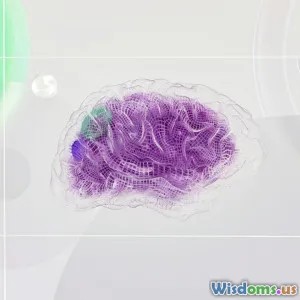
Design Thinking for Creative Solutions
8 min read Uncover how design thinking fuels creative graphic design solutions with user-focused strategies that transform ideas into impactful visuals. (0 Reviews)
Design Thinking for Creative Solutions in Graphic Design
Graphic design today thrives at the intersection of art, psychology, and innovation. However, the true artistry lies not just in creating beautiful visuals but solving real-world problems through creative solutions. That’s where design thinking emerges as a transformative process. Rooted in empathy, collaboration, and iterative development, design thinking reshapes how graphic designers approach challenges, offering a pathway from conceptual ambiguity to impactful visual communication.
Introduction: Beyond Aesthetics – Design Thinking as a Catalyst
When was the last time a poster, logo, or branding made you think not just "Wow, that looks good," but also "How did they understand me so well?" The art of graphic design is no longer just about aesthetics—it’s about addressing the viewer’s unconscious needs, usability, and emotional connection. Design thinking, a human-centered methodology popularized by innovators at Stanford’s d.school and IDEO, offers graphic designers a cultural and practical framework to develop innovative solutions tailored to users.
What is Design Thinking?
Design thinking is a structured creative problem-solving approach focused on understanding users, generating ideas, prototyping, and testing. It breaks away from traditional linear workflows by emphasizing empathy and feedback loops, an approach that’s particularly vital in graphic design where audience perception is everything.
The Five Stages of Design Thinking Applied to Graphic Design
1. Empathize: Understanding the Audience Deeply
Empathy is the cornerstone of meaningful design. Successful graphic designers do not just throw colors and fonts randomly—they start by deeply understanding their audience's desires, pain points, and cultural contexts.
For example, when Airbnb underwent a brand refresh in 2014, they invested heavily in ethnographic research—observing how their users experienced travel and homes. This empathy drove the creation of the "Bélo" symbol representing "belonging," perfectly resonating with its global audience. This approach shows how empathizing lays the foundation for narrative-driven graphic solutions.
2. Define: Articulating the Core Design Challenge
After gathering insights, framing the problem effectively is crucial. Ambiguity often stalls creativity. Instead of broad briefs like "create a logo," framing specific challenges such as "how can we visually communicate trust and community in the logo for a home-sharing platform?" guides the designer to place audience needs central to all subsequent decisions.
3. Ideate: Exploring Divergent Creative Solutions
Graphic designers then generate a wide range of ideas without filtering. This phase encourages wild brainstorming, mind mapping, and sketching to explore possibilities beyond the obvious.
In practice, a designer creating brand visuals for an eco-friendly startup might ideate not only on leaf motifs but also on concepts such as growth, sustainability cycles, and nature’s textures—inviting unconventional symbolism.
The power of ideation lies in not prematurely narrowing down concepts, fostering a large pool of ideas to test and refine.
4. Prototype: Making Ideas Tangible
Prototyping in graphic design involves creating mockups—from quick sketches to digital wireframes and interactive prototypes. These prototypes embody visual solutions in a form that can be evaluated and iterated upon.
For instance, designing a website layout quickly built in Adobe XD or Sketch enables user feedback before coding begins, saving time and ensuring alignment with user expectations.
5. Test: Refining Based on Feedback
Testing gathers real or simulated user reactions to prototypes. Graphic design is subjective, but targeted feedback highlights how well visuals convey intended messages and evoke emotions.
A study cited in the Nielsen Norman Group reveals that iterative user testing can reduce usability errors by up to 90%, reinforcing the importance of continuous refinement.
Real-World Applications: Design Thinking Driving Breakthrough Visuals
-
Google Material Design: Google applied design thinking in developing its Material Design system by empathizing with developers needing clarity, defining the problem as unifying UX guidelines, ideating varied components, prototyping interfaces, and testing extensively. The result? A coherent and visually engaging design language adopted globally.
-
Pentagram’s Rebrand of the Mozilla Logo (2017): By focusing on community and openness in their empathy phase, Pentagram crafted a bold, dynamic logo embodying Mozilla’s mission. The team's iterative prototyping ensured the logo balanced modernity with heritage.
Why Graphic Designers Must Embrace Design Thinking
Drives User-Centered Visuals
Design thinking ensures visuals aren’t just personal artistic statements but solutions addressing user needs, making the communication relevant and effective.
Promotes Innovation and Originality
Structured phases allow designers to break away from clichés by pushing through abundant ideation before crystallizing final designs.
Encourages Collaboration and Cross-Disciplinary Insights
Design thinking’s collaborative nature means designers engage alongside marketers, researchers, and end-users, enriching perspectives and outcomes.
Adaptive in Fast-Paced Environments
In a digital era of rapid trends and technologies, iterative prototyping and testing help designers remain agile and responsive.
How To Start Integrating Design Thinking in Your Graphic Design Workflow
- Develop Empathy Maps and User Personas: Understand and document your audience’s feelings and behaviors.
- Use "How Might We" Statements: Clearly define design challenges that invite creative solutions.
- Brainstorm with Quantity, Not Quality at First: Encourage diverse ideas before refining.
- Create Low-Fi Prototypes Quickly: Sketches, wireframes, and mood boards accelerate feedback cycles.
- Seek Feedback Early and Often: From peers, clients, and end-users.
Conclusion: Reimagining Creativity Through Design Thinking
Design thinking transforms graphic design from a purely aesthetic endeavor into a strategic, human-centered practice. By embedding empathy, defining clear challenges, expanding ideation, prototyping rapidly, and testing thoroughly, graphic designers can uncover solutions that resonate deeply and perform effectively.
In the evolving creative landscape, mastering design thinking equips graphic designers not just to make things look good but to make visuals that truly work—inspiring users, solving problems, and making an impact that lasts. Start applying design thinking today to elevate your creative process and design with intention and innovation.
References:
- Kelley, T., & Kelley, D. (2013). Creative Confidence. Crown Business.
- Nielsen Norman Group, Usability Studies.
- Airbnb Brand Case Study – Design Thinking in Practice
- Google Material Design Guidelines
- Mozilla Logo Rebranding by Pentagram
Rate the Post
User Reviews
Popular Posts




















